2007 CHEVROLET SILVERADO change wheel
[x] Cancel search: change wheelPage 580 of 684
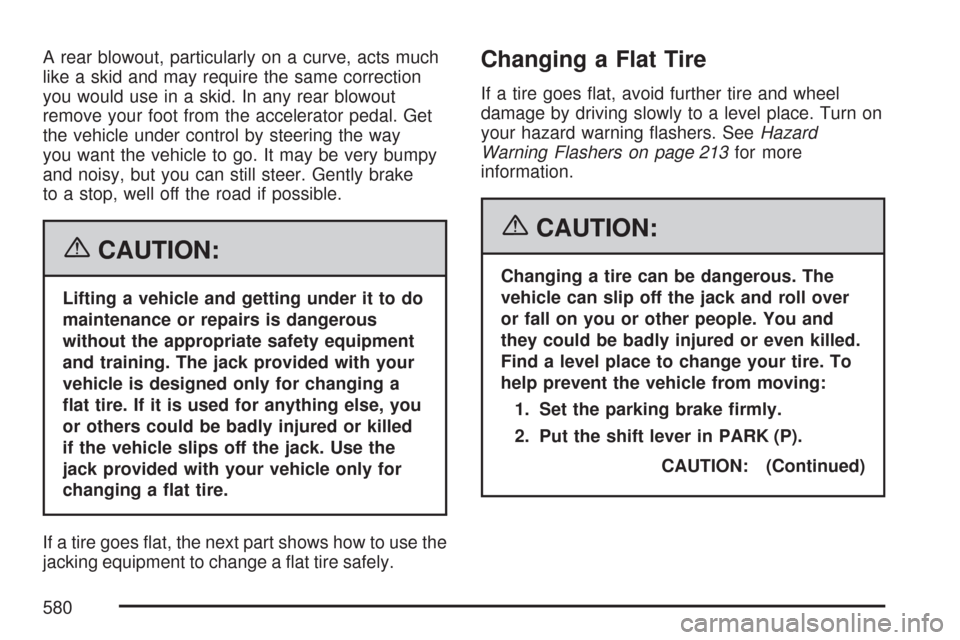
A rear blowout, particularly on a curve, acts much
like a skid and may require the same correction
you would use in a skid. In any rear blowout
remove your foot from the accelerator pedal. Get
the vehicle under control by steering the way
you want the vehicle to go. It may be very bumpy
and noisy, but you can still steer. Gently brake
to a stop, well off the road if possible.
{CAUTION:
Lifting a vehicle and getting under it to do
maintenance or repairs is dangerous
without the appropriate safety equipment
and training. The jack provided with your
vehicle is designed only for changing a
�at tire. If it is used for anything else, you
or others could be badly injured or killed
if the vehicle slips off the jack. Use the
jack provided with your vehicle only for
changing a �at tire.
If a tire goes �at, the next part shows how to use the
jacking equipment to change a �at tire safely.
Changing a Flat Tire
If a tire goes �at, avoid further tire and wheel
damage by driving slowly to a level place. Turn on
your hazard warning �ashers. SeeHazard
Warning Flashers on page 213for more
information.
{CAUTION:
Changing a tire can be dangerous. The
vehicle can slip off the jack and roll over
or fall on you or other people. You and
they could be badly injured or even killed.
Find a level place to change your tire. To
help prevent the vehicle from moving:
1. Set the parking brake �rmly.
2. Put the shift lever in PARK (P).
CAUTION: (Continued)
580
Page 581 of 684
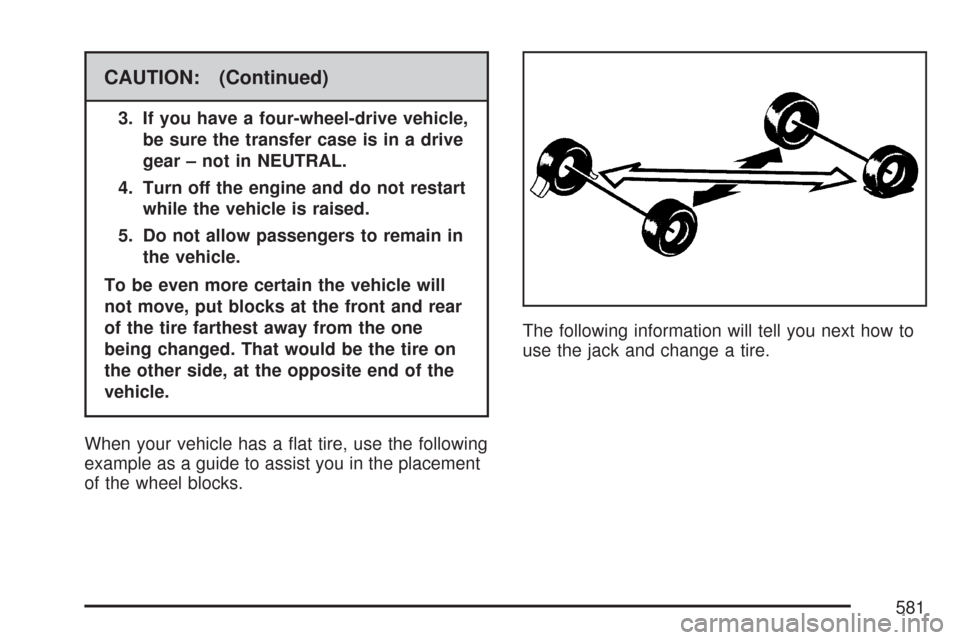
CAUTION: (Continued)
3. If you have a four-wheel-drive vehicle,
be sure the transfer case is in a drive
gear – not in NEUTRAL.
4. Turn off the engine and do not restart
while the vehicle is raised.
5. Do not allow passengers to remain in
the vehicle.
To be even more certain the vehicle will
not move, put blocks at the front and rear
of the tire farthest away from the one
being changed. That would be the tire on
the other side, at the opposite end of the
vehicle.
When your vehicle has a �at tire, use the following
example as a guide to assist you in the placement
of the wheel blocks.The following information will tell you next how to
use the jack and change a tire.
581
Page 632 of 684
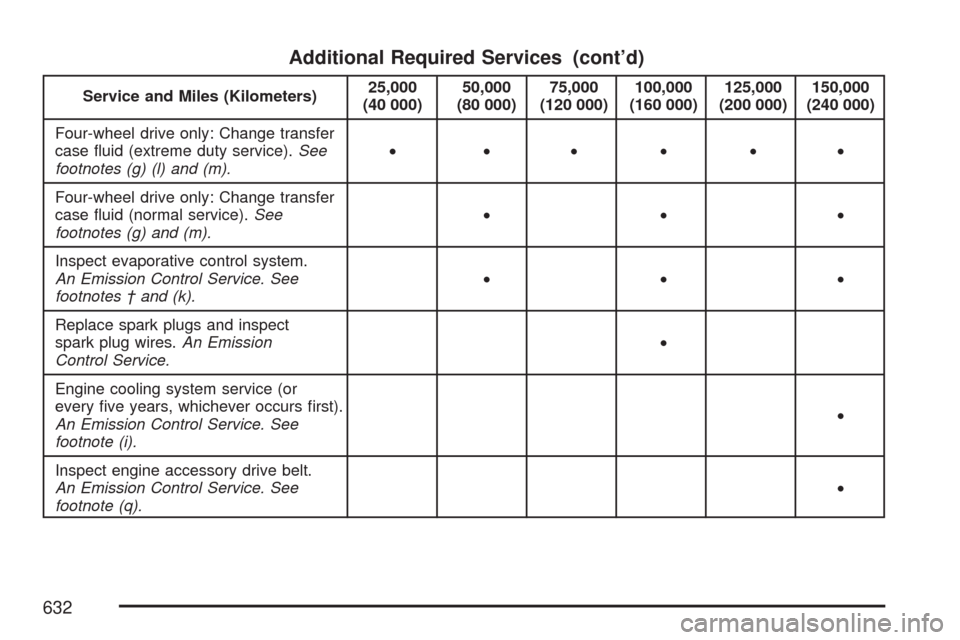
Additional Required Services (cont’d)
Service and Miles (Kilometers)25,000
(40 000)50,000
(80 000)75,000
(120 000)100,000
(160 000)125,000
(200 000)150,000
(240 000)
Four-wheel drive only: Change transfer
case �uid (extreme duty service).See
footnotes (g) (l) and (m).• •••••
Four-wheel drive only: Change transfer
case �uid (normal service).See
footnotes (g) and (m).•••
Inspect evaporative control system.
An Emission Control Service. See
footnotes † and (k).•••
Replace spark plugs and inspect
spark plug wires.An Emission
Control Service.•
Engine cooling system service (or
every �ve years, whichever occurs �rst).
An Emission Control Service. See
footnote (i).•
Inspect engine accessory drive belt.
An Emission Control Service. See
footnote (q).•
632
Page 635 of 684
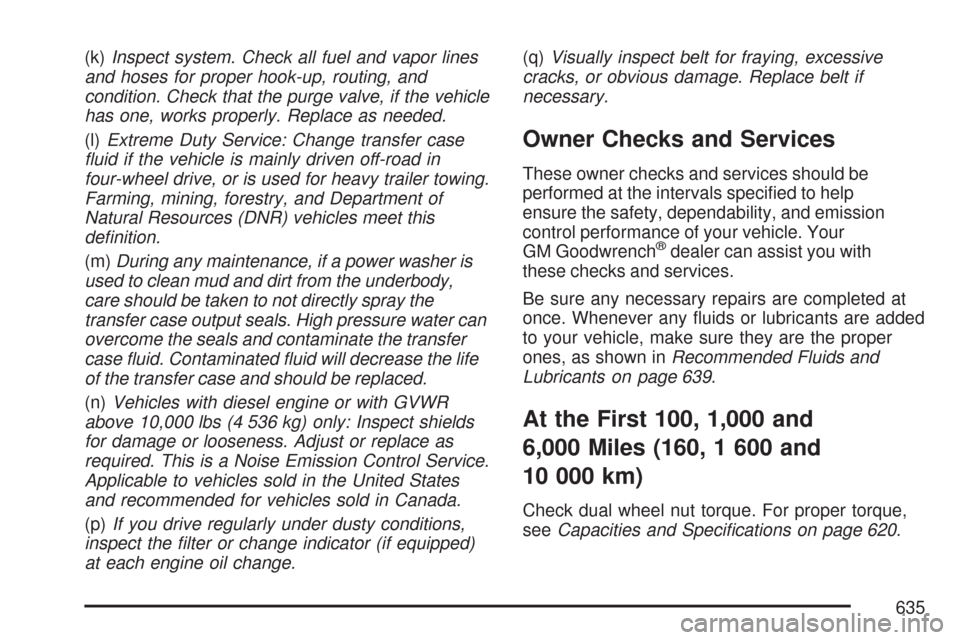
(k)Inspect system. Check all fuel and vapor lines
and hoses for proper hook-up, routing, and
condition. Check that the purge valve, if the vehicle
has one, works properly. Replace as needed.
(l)Extreme Duty Service: Change transfer case
�uid if the vehicle is mainly driven off-road in
four-wheel drive, or is used for heavy trailer towing.
Farming, mining, forestry, and Department of
Natural Resources (DNR) vehicles meet this
de�nition.
(m)During any maintenance, if a power washer is
used to clean mud and dirt from the underbody,
care should be taken to not directly spray the
transfer case output seals. High pressure water can
overcome the seals and contaminate the transfer
case �uid. Contaminated �uid will decrease the life
of the transfer case and should be replaced.
(n)Vehicles with diesel engine or with GVWR
above 10,000 lbs (4 536 kg) only: Inspect shields
for damage or looseness. Adjust or replace as
required. This is a Noise Emission Control Service.
Applicable to vehicles sold in the United States
and recommended for vehicles sold in Canada.
(p)If you drive regularly under dusty conditions,
inspect the �lter or change indicator (if equipped)
at each engine oil change.(q)Visually inspect belt for fraying, excessive
cracks, or obvious damage. Replace belt if
necessary.
Owner Checks and Services
These owner checks and services should be
performed at the intervals speci�ed to help
ensure the safety, dependability, and emission
control performance of your vehicle. Your
GM Goodwrench
®dealer can assist you with
these checks and services.
Be sure any necessary repairs are completed at
once. Whenever any �uids or lubricants are added
to your vehicle, make sure they are the proper
ones, as shown inRecommended Fluids and
Lubricants on page 639.
At the First 100, 1,000 and
6,000 Miles (160, 1 600 and
10 000 km)
Check dual wheel nut torque. For proper torque,
seeCapacities and Speci�cations on page 620.
635
Page 681 of 684
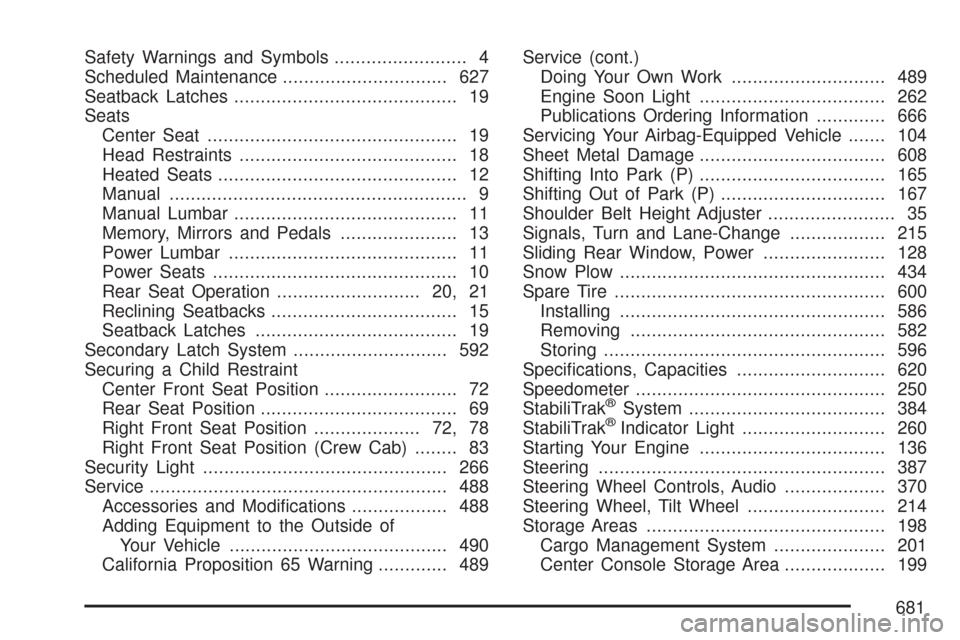
Safety Warnings and Symbols......................... 4
Scheduled Maintenance............................... 627
Seatback Latches.......................................... 19
Seats
Center Seat............................................... 19
Head Restraints......................................... 18
Heated Seats............................................. 12
Manual........................................................ 9
Manual Lumbar.......................................... 11
Memory, Mirrors and Pedals...................... 13
Power Lumbar........................................... 11
Power Seats.............................................. 10
Rear Seat Operation........................... 20, 21
Reclining Seatbacks................................... 15
Seatback Latches...................................... 19
Secondary Latch System............................. 592
Securing a Child Restraint
Center Front Seat Position......................... 72
Rear Seat Position..................................... 69
Right Front Seat Position.................... 72, 78
Right Front Seat Position (Crew Cab)........ 83
Security Light.............................................. 266
Service........................................................ 488
Accessories and Modi�cations.................. 488
Adding Equipment to the Outside of
Your Vehicle......................................... 490
California Proposition 65 Warning............. 489Service (cont.)
Doing Your Own Work............................. 489
Engine Soon Light................................... 262
Publications Ordering Information............. 666
Servicing Your Airbag-Equipped Vehicle....... 104
Sheet Metal Damage................................... 608
Shifting Into Park (P)................................... 165
Shifting Out of Park (P)............................... 167
Shoulder Belt Height Adjuster........................ 35
Signals, Turn and Lane-Change.................. 215
Sliding Rear Window, Power....................... 128
Snow Plow.................................................. 434
Spare Tire................................................... 600
Installing.................................................. 586
Removing................................................ 582
Storing..................................................... 596
Speci�cations, Capacities............................ 620
Speedometer............................................... 250
StabiliTrak
®System..................................... 384
StabiliTrak®Indicator Light........................... 260
Starting Your Engine................................... 136
Steering...................................................... 387
Steering Wheel Controls, Audio................... 370
Steering Wheel, Tilt Wheel.......................... 214
Storage Areas............................................. 198
Cargo Management System..................... 201
Center Console Storage Area................... 199
681
Page 683 of 684
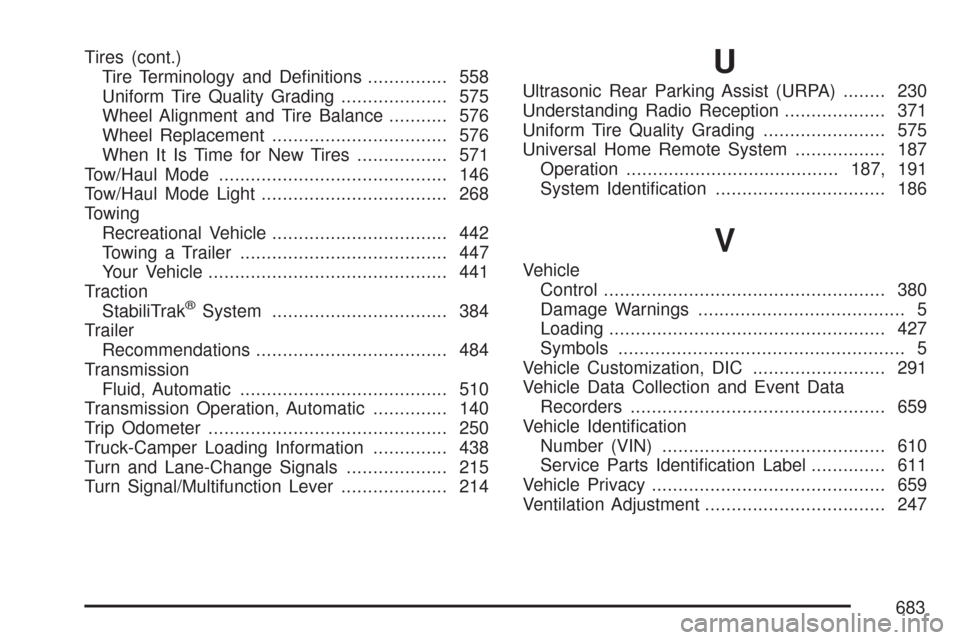
Tires (cont.)
Tire Terminology and De�nitions............... 558
Uniform Tire Quality Grading.................... 575
Wheel Alignment and Tire Balance........... 576
Wheel Replacement................................. 576
When It Is Time for New Tires................. 571
Tow/Haul Mode........................................... 146
Tow/Haul Mode Light................................... 268
Towing
Recreational Vehicle................................. 442
Towing a Trailer....................................... 447
Your Vehicle............................................. 441
Traction
StabiliTrak
®System................................. 384
Trailer
Recommendations.................................... 484
Transmission
Fluid, Automatic....................................... 510
Transmission Operation, Automatic.............. 140
Trip Odometer............................................. 250
Truck-Camper Loading Information.............. 438
Turn and Lane-Change Signals................... 215
Turn Signal/Multifunction Lever.................... 214
U
Ultrasonic Rear Parking Assist (URPA)........ 230
Understanding Radio Reception................... 371
Uniform Tire Quality Grading....................... 575
Universal Home Remote System................. 187
Operation........................................187, 191
System Identi�cation................................ 186
V
Vehicle
Control..................................................... 380
Damage Warnings....................................... 5
Loading.................................................... 427
Symbols...................................................... 5
Vehicle Customization, DIC......................... 291
Vehicle Data Collection and Event Data
Recorders................................................ 659
Vehicle Identi�cation
Number (VIN).......................................... 610
Service Parts Identi�cation Label.............. 611
Vehicle Privacy............................................ 659
Ventilation Adjustment.................................. 247
683